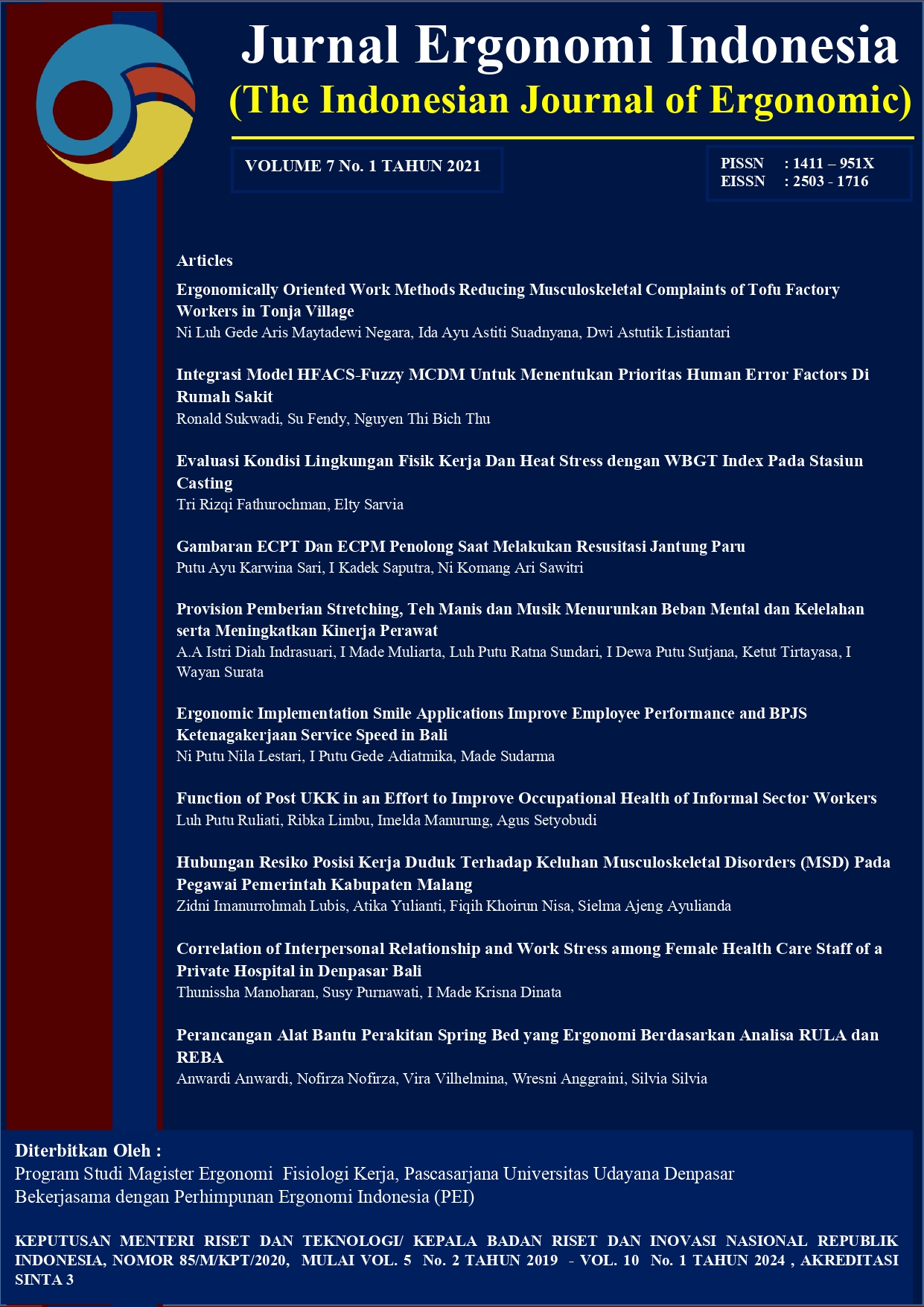Integrasi Model HFACS-Fuzzy MCDM Untuk Menentukan Prioritas Human Error Factors Di Rumah Sakit
Abstract
Medical errors caused by human can occur in health services at the hospitals. Various solutions can be applied to avoid the problem of medical errors. One of the solution is Human Factor Analysis and Classification System (HFACS) which is a systematic method that analyze errors made by humans classified in several categories of error factors. HFACS also assesses all damage that occurs to the system resulting in work accidents. This study proposes the handling of priority factors of accidents caused by humans where the priority is based on a classification system on identifying HFACS. Selection for the priority of increasing human error factors in HFACS uses the Multi Criteria Decision Making method, which is an integration of F-AHP and F-TOSPIS, that able to combine historical data and expert opinion so as to get priority on human error factors. It was found that the weight calculation results for the effect criteria were 57%, reproducibility was 25.3 % and prevention was 17.7% with the main priority of human error factors is inadequate supervision of 10.7%.
Downloads
References
Chen, G., Pham, dan Trung Tat. 2001. Introduction to Fuzzy Sets, Fuzzy Logic, and Fuzzy Control Systems. USA: CRC Press
Diller, T., Helmrich, G., Dunning, S., Cox, S., Buchanan, A., dan Shappell, S. 2013. The human factors analysis classification system applied to health care. American Journal of Medical Quality, Vol. 29(3):181-90. https://doi.org/10.1177/1062860613491623
Hsieh, M.C., Min-yang, E., Lee, W.C., Li L. W., Hsieh, C. Y., Tsai, W., Wang., C.P., Huang, J.L., dan Liu, T.C. 2018. Application of HFACS, fuzzy TOPSIS, and AHP for identifying important human error factors in emergency departments in Taiwan. International Journal of Industrial Ergonomics, Vol. 67:171-179. https://doi.org/10.1016/j.ergon.2018.05.004
Junior, L.F.R., Osiro, L., dan Carpinetti, L.C.R. 2014. A comparison between fuzzy AHP and fuzzy TOPSIS methods to supplier selection. Applied Soft Computing, Vol. 21:194-209. https://doi.org/10.1016/j.asoc.2014.03.014
Kaganski, S., Majak, J., Karjust, K. 2018. Fuzzy AHP as a tool for prioritization of key performance indicators. Proceedings of the International Journal of 51st CIRP Conference on Manufacturing Systems, (pp. 1227-1232). https://doi.org/10.1016/j.procir.2018.03.097
Kavanagh, K.T., Saman, D. M., Bartel, R., dan Westerman, K. 2017. Estimating hospital-related deaths due to medical error: A perspective from patient advocates. International Journal of Wolters Kluwer Heath, Vol. 13(1):1-5. https://doi.org/10.1097/PTS.0000000000000364
Khoshi, A., Shams Gooshki, H., dan Mahmoudi, N. 2018. The data on the effective qualifications of teachers in medical sciences: An application of combined fuzzy AHP and fuzzy TOPSIS methods. Data in Brief, Vol. 21:2689-2693. https://doi.org/10.1016/j.dib.2018.10.165
Marimin. 2005. Teknik dan Aplikasi Pengambilan Keputusan Kriteria Majemuk. Jakarta: Gramedia Widiasarana Indonesia.
Mitchell, R. J., William, A., dan Molesworth, B. 2016. Application of a human factors classification framework for patient safety to identify precursor and contributing factors to adverse clinical incidents in hospital. Journal of Applied Ergonomics, Vol. 52:185-195. https://doi.org/10.1016/j.apergo.2015.07.018
Olsen, N., dan Williamson, A. 2017. Application of classification principles to improve the reliability of incident classification system: A test case using HFACS-ADF. Journal of Applied Ergonomics, Vol. 63(2):31-40. https://doi.org/10.1016/j.apergo.2017.03.014
Pel, Z., Liu, J., Hao, F., dan Zhou, B. 2017. FLM-TOPSIS: The fuzzy linguistic multiset TOPSIS method and its application in linguistic decision making. International Journal of Information Fusion, Vol. 45: 266-281. https://doi.org/10.1016/j.inffus.2018.01.013
Prasongko, N. D., dan Gernowo, R. 2015. Metode quality function deployment dan fuzzy TOPSIS untuk sistem pendukung keputusan pemilihan perusahaan penyedia jasa internet. Jurnal Sistem Informasi Bisnis, Vol. 5(2):137-144. https://doi.org/10.21456/vol5iss2pp137-144
Shappell, S. A., dan Wiegmann, D. A. 2003. A Human Error Approach to Aviation Accident Analysis: The Human Factors Analysis and Classification System. USA: Ashgate Publishing Company.
Shega, H. N., Rahmawati, R., dan Yasin, H. 2012. Penentuan faktor prioritas mahasiswa dalam memilih telepon seluler merk Blackberry dengan Fuzzy AHP. Jurnal Statistika Undip, Vol. 1(1): 73-82.
Sukwadi, R. 2013. Pengembangan model integrasi Delphi-AHP-Markov dalam perencanaan kebutuhan sumber daya manusia, Spektrum Industri, Vol. 11(2):117-242. https://doi.org/10.12928/si.v11i2.1664
Sukwadi, R., Wenehenubun, F, dan Wenehenubun, T.W. 2017. Pendekatan Fuzzy FMEA dalam analisis faktor risiko kecelakaan kerja, Jurnal Rekayasa Sistem Industri, Vol. 6(1):29-38. https://doi.org/10.26593/jrsi.v6i1.2425.29-38
Sukwadi, R., Yang, C.C., dan Benny. 2014. Integrasi fuzzy AHP-TOPSIS dalam evaluasi kualitas layanan elektronik rumah sakit, Jurnal Teknik Industri: Jurnal Keilmuan dan Aplikasi Teknik Industri, Vol. 16(1):25-34. https://doi.org/10.9744/jti.16.1.25-34

















